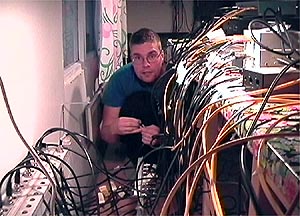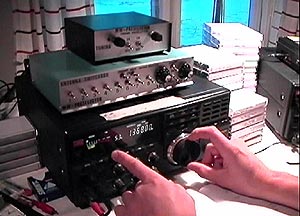|
LEM169 DXpedition
Equipment
November 23-30, 2002
by Mika
Mäkeläinen
Borrowing a couple
of receivers from friends, we had a total of four
JRC NRD-535s, one JRC NRD-545 DSP and one Icom 8500.
Additional equipment included amplifiers, antenna
tuners and antenna switchboards. Both had a switchboard
designed by Roland Sandberg to select the antennas
and, if necessary, to split a particular antenna
between two receivers. An "active splitter"
was used to divide all the essential antennas between
the listeners.

Now where does this wire go? |
This time the Lemmenjoki
cabin was equipped with 10 beverage (terminated)
or longwire (not terminated) antennas. Additionally
a couple of 300-meter-long wires to North America
were available, without the usual 700-meter extension.
Most of the antennas needed to be split between
both users when conditions focused on a particular
region of interest. For example, there was only
one good antenna for the U.S. East Coast, one for
the Iberian Peninsula and one for both the Southern
part of South America. Since our antenna splitters
were able to handle a maximum of nine antennas,
that was the amount we used.

Jim's NRD-535 with a switchboard
and an amplifier |
Each antenna was 0.8 - 1.1 kilometers
(0.5 - 0.7 miles) in length. Because of the reindeer,
antennas needed to be 3-4 meters above the ground.
Wherever trees are not available, poles have been
erected. This time antennas were pointed at the
following areas:
- Iberian Peninsula (240 degrees)
- Southern part of South America (Brazil, Uruguay,
Argentina, Chile) and the United Kingdom (245 degrees)
- Northern part of South America (Venezuela, Columbia,
Ecuador) and the Caribbean (275/282 degrees)
- Eastern Coast of North America and Central America
(290 degrees)
- Midwest (290, 297 and 312 degrees)
- Rocky Mountains (320 degrees)
- West Coast of North America (327 degrees)
- north towards Alaska and Hawaii (0 degrees)
- East Asia (China, Taiwan, the Philippines) at
80 degrees
Nothing new on the recording
front; Mika relied mostly on minidiscs (Sony MDS-JE520
deck and a portable Sony MZ-R35), but also had a
Pioneer CT-S330 cassette deck. Jim used portable
cassette decks.
  
|